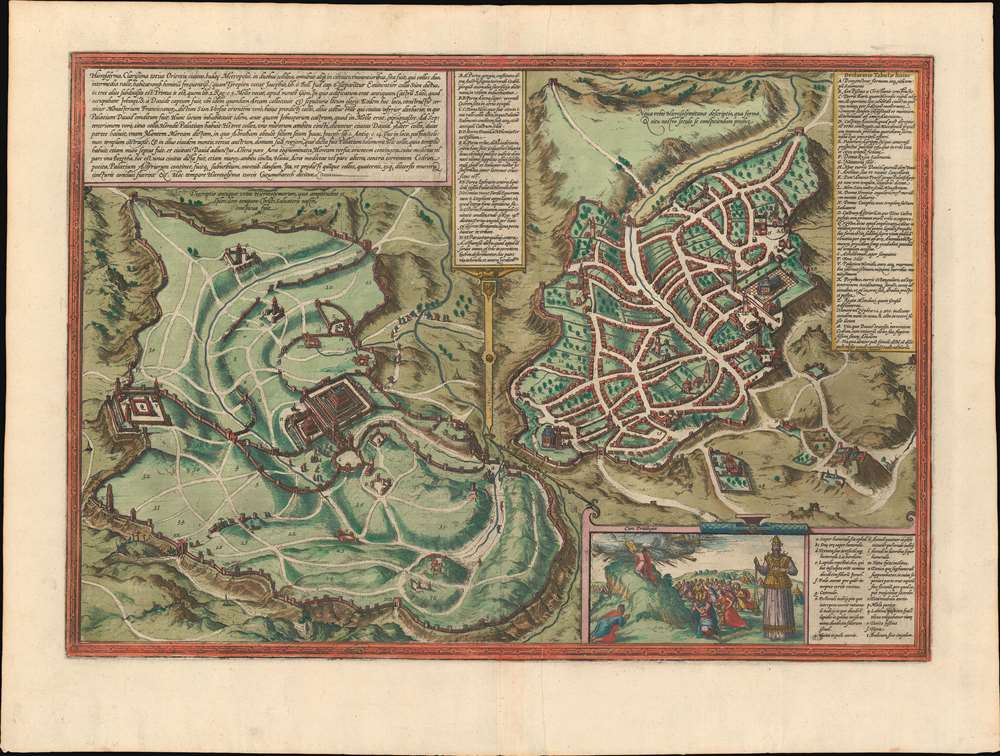This item has been sold, but you can get on the Waitlist to be notified if another example becomes available, or purchase a digital scan.
1572 Braun and Hogenberg Map of Jerusalem
Jerusalem-braun-1572
Title
1572 (undated) 14 x 19.5 in (35.56 x 49.53 cm)
Description
A view of Jerusalem as it was in the late 16th century, when Braun and Hogenberg created this stunning piece, is situated on the right side of the sheet. Monuments and other locations throughout the city are labeled using both capital and lower-case letters that correspond with a table located on the right side of the view. Some of these monuments are illustrated in both views, creating a connection between the ancient city and its modern iteration. A brilliant concept, this allows the viewer to feel as if they can almost touch Biblical Jerusalem, both by being in possession of the map itself, and by visiting the sites that survived the centuries and still stood in Jerusalem at that point in history. An inset situated in the lower right corner illustrated Moses receiving the Ten Commandments on Mt. Sinai. Aaron is also illustrated in the inset dressed in extravagant garments and other accoutrements. A table next to Aaron identifies all the garments and other objects worn or held by Aaron.
This double-view was drawn by Georg Braun and Frans Hogenberg and published in their Civitates Orbis Terrarum, the most famous and influential 16th century book of town plans.
CartographerS
Georg Braun (1541 – March 10, 1622) was a German deacon, viewmaker, and typo-geographer based in Cologne. Along with Franz Hogenberg (1535 - 1590), Braun is best known for his publication of the highly influential city atlas Civitates Orbis Terrarum. The six volume work, with some 546 views, was published between 1572 and 1617 and intended a companion to Abraham Ortelius' Theatrum Orbis Terrarum - thus certain obvious stylistic similarities. In compiling the Civitates Braun took on the role of editor while most of the engraving work was completed by Franz Hogenberg. Braun died, as he was born, in Cologne. More by this mapmaker...
Franz Hogenberg (1535 - 1590), often called 'Master Franz,' was a Flemish engraver active in the late 16th century. Hogenberg was born in Mechelen, the son of Nicolas Hogenberg, where he trained under the cartographer H. Terbruggen. He later relocated to Antwerp where he achieved success as an engraver, working with Abraham Ortelius, Hieronymus Cock, and others. In 1568, his name appeared on the list of those banned from the Netherlands by the Duke of Alva, forcing his family to flee to London. There he engraved for Christopher Saxon's Atlas of England and Wales. By 1570 he emigrated to Germany settling in Cologne. In Cologne he married his second wife, Agnes Lomar, with whom he had six children. In 1579 the couple were briefly imprisoned for holding illicit secret religious meetings, but were released in short order. Along with German cleric George Braun (1541 – March 10, 1622), Hogenberg issued the highly influential city atlas Civitates Orbis Terrarum. The six volume work, with some 546 views, was published between 1572 and 1617 and intended a companion to Abraham Ortelius' Thatrum Orbis Terrarum - thus certain obvious stylistic similarities. In compiling the Civitates Hogenberg took on the role of engraver while most of the editing was left to Georg Braun. Hogenberg died in Cologne, Germany, before the Civitates was completed. After his death, Hogenberg's work was continued by his son, Abraham Hogenberg, who, under the direction of Agnes, his mother, took over his father's enterprise at just 20. Learn More...
Source
- Civitates orbis terrarium, first edition 1572.
- De praecipuis, totius universi urbibus, liber secundus, first edition 1575.
- Urbium praecipuarum totius mundi, liber tertius, first edition 1581.
- Urbium praecipuarum totius mundi, liber quartus, first edition 1588.
- Urbium praecipuarum mundi theatrum quintum, first edition 1596.
- Theatri praecipuarum totius mundi urbium liber sextus, first edition 1617.

